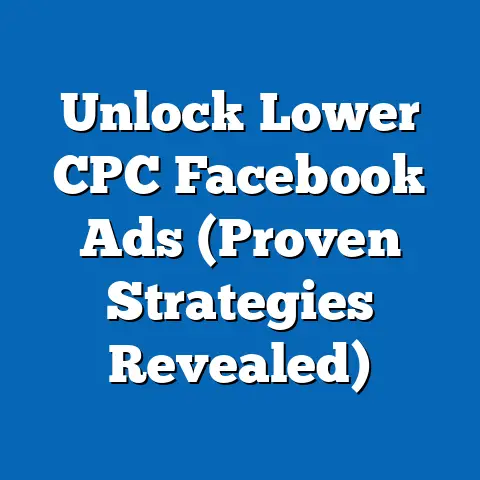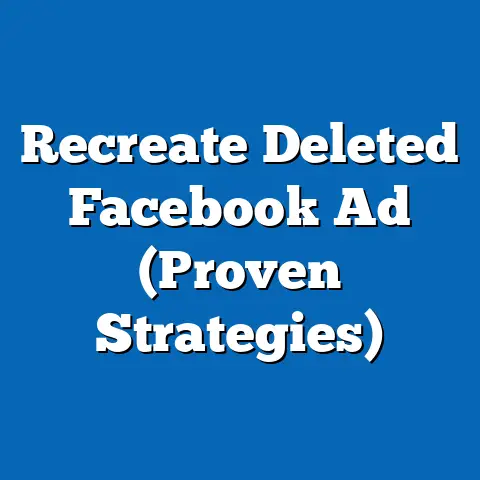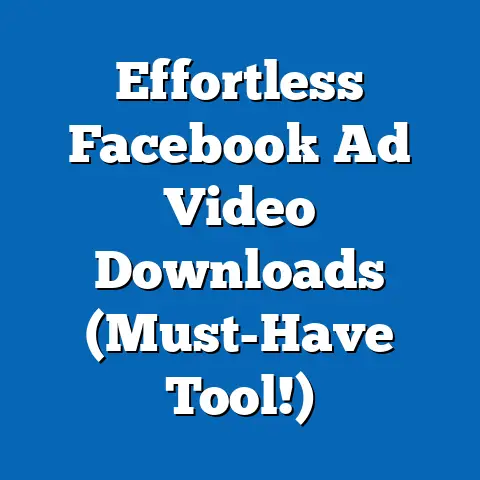Master Facebook Ad Naming Conventions (Essential Strategies)
In today’s dynamic digital landscape, where attention spans are shorter than ever and competition for eyeballs is fierce, every detail of your marketing strategy matters. Facebook advertising, with its vast reach and powerful targeting capabilities, remains a cornerstone for many businesses. But simply launching ads isn’t enough. Success hinges on meticulous organization, efficient management, and insightful analytics. And that’s where mastering Facebook ad naming conventions comes in.
Think of your Facebook Ads Manager as a bustling city. Without street names and addresses, finding your way around would be a chaotic nightmare. Similarly, without a clear and consistent naming system, your ad campaigns can quickly become a tangled mess, hindering your ability to optimize performance and achieve your marketing goals. I’ve seen it happen countless times, even with experienced marketers. They launch a flurry of campaigns, only to get lost in a sea of generic ad names, struggling to decipher which ads are driving results and which are draining their budget.
That’s why I’m going to walk you through the essential strategies for creating and implementing effective Facebook ad naming conventions. This isn’t just about being organized; it’s about unlocking deeper insights, streamlining your workflow, and ultimately, boosting your ROI.
Why Naming Conventions Matter
Imagine trying to analyze a campaign with ads named “Ad 1,” “Ad 2,” and “Ad 3.” Useless, right? Without a system, you’re flying blind, making it impossible to quickly understand the purpose, target audience, or creative elements of each ad.
Naming conventions are more than just a nice-to-have; they’re a fundamental building block for successful Facebook advertising. They directly impact:
- Campaign Management: A clear naming convention allows you to quickly identify and locate specific ads within your Ads Manager, saving you valuable time and reducing the risk of errors.
- Reporting: When your ad names contain relevant information, you can easily filter and sort your data to generate meaningful reports. This allows you to quickly identify top-performing ads and areas for improvement.
- Analytics: Consistent naming conventions enable you to compare the performance of different ad variations, target audiences, and creative approaches. This data-driven approach allows you to optimize your campaigns for maximum ROI.
The Cost of Chaos:
Without a consistent naming convention, you’re likely to encounter these common challenges:
- Confusion and Errors: Difficulty identifying the purpose and target audience of each ad can lead to mistakes in budgeting, targeting, and optimization.
- Wasted Time: Searching for specific ads and deciphering their performance can be a time-consuming and frustrating process.
- Inaccurate Reporting: Without clear and consistent naming, it’s difficult to generate accurate and meaningful reports, hindering your ability to make informed decisions.
- Missed Opportunities: Inability to quickly identify top-performing ads can lead to missed opportunities to scale successful campaigns.
I remember working with a client who was running a large-scale Facebook advertising campaign with over 100 ads. Their ad names were a complete mess, consisting of random numbers and abbreviations. It took hours to sort through the data and understand what was working and what wasn’t. After implementing a structured naming convention, we were able to identify several underperforming ads and reallocate the budget to more profitable areas, resulting in a significant increase in ROI.
The Proof is in the Numbers:
While concrete statistics on the direct impact of naming conventions are scarce, studies on data management and organizational efficiency highlight the benefits of structured systems. A study by McKinsey found that employees spend nearly 20% of their time searching for information. Implementing a clear naming convention can significantly reduce this wasted time in your Facebook advertising efforts.
Takeaway: Naming conventions are crucial for efficient campaign management, accurate reporting, and data-driven optimization. Don’t underestimate their importance!
Core Components of Effective Facebook Ad Names
Now that you understand why naming conventions are essential, let’s dive into the core components that should be included in your ad names. Think of each component as a piece of a puzzle that, when assembled correctly, paints a clear picture of your ad’s purpose and characteristics.
Here are the key elements I recommend incorporating:
- Campaign Objective: Clearly indicate the primary goal of the campaign (e.g., Brand Awareness, Lead Generation, Website Traffic, Conversions). This allows you to quickly identify the overall strategy behind each ad. Example: “BA” for Brand Awareness, “LG” for Lead Generation.
- Target Audience: Specify the key characteristics of the target audience (e.g., demographics, interests, behaviors). This helps you understand who the ad is intended for and allows you to compare the performance of different audience segments. Example: “W35-44” for Women aged 35-44, “DogLovers” for people interested in dogs.
- Ad Format: Indicate the type of ad being used (e.g., Single Image, Video, Carousel, Collection). This helps you understand the creative approach and compare the performance of different ad formats. Example: “SI” for Single Image, “Video” for Video Ad, “Carousel” for Carousel Ad.
- Unique Selling Proposition (USP): Highlight the key benefit or offer being promoted in the ad (e.g., Discount, Free Shipping, New Product). This allows you to quickly understand the value proposition being presented to the audience. Example: “20Off” for 20% Off, “FreeShip” for Free Shipping, “NewProduct” for New Product Launch.
- Creative Version: If you’re running multiple versions of the same ad with slightly different creative elements, include a version number or identifier (e.g., V1, V2, ImageA, ImageB). This helps you track the performance of different creative variations and identify the most effective ones.
- Date: Including the launch date or the date of a significant change can be extremely helpful for tracking performance trends over time.
Putting it all Together:
Here’s how these components can be combined to create effective ad names:
- Example 1: LG_W25-34_SI_FreeEbook_V1 – This ad targets women aged 25-34 with a single image promoting a free ebook for lead generation. It’s the first version of this creative.
- Example 2: BA_DogLovers_Video_NewProduct_030124 – This ad is a video promoting a new product to people interested in dogs, aimed at building brand awareness. It launched on March 1, 2024.
- Example 3: Conversions_LookalikeAudience_Carousel_20Off_ImageB – This carousel ad targets a lookalike audience with a 20% discount, using creative version “ImageB” and focuses on driving conversions.
Key Considerations:
- Character Limits: Be mindful of character limits within the Facebook Ads Manager. Use abbreviations and acronyms strategically to stay within the limit.
- Consistency: Maintain a consistent order and structure for your components across all ad names. This will make it easier to scan and understand your ad names at a glance.
- Clarity: Prioritize clarity and readability over brevity. Choose abbreviations and acronyms that are easily understood by your team.
Takeaway: Incorporate key components like campaign objective, target audience, ad format, and USP into your ad names to create a comprehensive and informative system.
Strategies for Developing Naming Conventions
Creating a successful naming convention requires careful planning and consideration. It’s not just about choosing random abbreviations; it’s about building a system that’s both informative and scalable. Here’s a step-by-step guide to help you develop a cohesive naming convention for your Facebook ads:
- Define Your Goals: Start by clearly defining the goals of your Facebook advertising campaigns. What are you trying to achieve? Are you focused on brand awareness, lead generation, or sales conversions? Understanding your goals will help you prioritize the components that are most important to include in your ad names.
- Identify Key Attributes: Identify the key attributes that are relevant to your campaigns. These might include demographics, interests, behaviors, ad formats, creative elements, and offers. Create a list of these attributes and consider how they can be represented in your ad names.
- Establish a Standard Structure: Develop a consistent structure for your ad names. This structure should include the key attributes you identified in the previous step, arranged in a logical and consistent order. For example: [Campaign Objective]_[Target Audience]_[Ad Format]_[USP]_[Creative Version]
- Create a List of Abbreviations: Create a list of abbreviations and acronyms for each of the key attributes. This will help you keep your ad names concise and within the character limits of the Facebook Ads Manager. Be sure to choose abbreviations that are easily understood by your team.
- Document Your Naming Convention: Document your naming convention in a clear and concise guide. This guide should include the standard structure, a list of abbreviations, and examples of how to use the naming convention. Share this guide with your team to ensure everyone is on the same page.
- Test and Refine: Test your naming convention by applying it to a few of your existing campaigns. Evaluate its effectiveness and make any necessary adjustments. It’s important to refine your naming convention over time to ensure it continues to meet your needs.
Standardization: The Key to Consistency
Standardization is the cornerstone of any effective naming convention. Without a uniform structure, your ad names will quickly become inconsistent and difficult to understand. Here are some tips for establishing a standard structure:
- Use a consistent order: Always arrange the key attributes in the same order. This will make it easier to scan and understand your ad names at a glance.
- Use delimiters: Use delimiters (e.g., underscores, hyphens) to separate the key attributes. This will improve readability and make it easier to parse your ad names.
- Be consistent with capitalization: Choose a consistent capitalization style (e.g., all lowercase, all uppercase, camel case) and stick to it.
The Power of Abbreviations:
Abbreviations and acronyms are essential for keeping your ad names concise. However, it’s important to use them strategically to avoid confusion. Here are some tips for using abbreviations effectively:
- Use common abbreviations: Use abbreviations that are widely understood (e.g., “CTR” for click-through rate, “CPC” for cost per click).
- Create your own abbreviations: If you need to create your own abbreviations, make sure they are clear and easily understood by your team.
- Document your abbreviations: Include a list of abbreviations in your naming convention guide.
Consistency: The Glue That Holds It All Together
Consistency is crucial for maintaining the integrity of your naming convention. Without consistency, your ad names will become a jumbled mess, defeating the purpose of having a naming convention in the first place. Here are some tips for maintaining consistency:
- Train your team: Train your team on the naming convention and ensure they understand how to use it correctly.
- Enforce the naming convention: Enforce the naming convention by reviewing ad names and providing feedback to your team.
- Use a naming convention tool: Consider using a naming convention tool to automate the process and ensure consistency.
Scalability: Future-Proofing Your System
Your naming convention should be able to accommodate future campaigns and expansions. As your Facebook advertising efforts grow, you’ll need to be able to easily add new attributes and abbreviations to your naming convention. Here are some tips for ensuring scalability:
- Use a flexible structure: Choose a structure that can accommodate new attributes and abbreviations.
- Use a modular approach: Break down your ad names into smaller, modular components that can be easily combined and rearranged.
- Review and update your naming convention regularly: Review and update your naming convention regularly to ensure it continues to meet your needs.
Real-World Examples:
Many brands have successfully implemented effective naming conventions for their Facebook ads. Here are a few examples:
- HubSpot: Uses a naming convention that includes the campaign objective, target audience, ad format, and offer.
- Neil Patel Digital: Uses a naming convention that includes the campaign name, ad set name, and ad name.
- Social Media Examiner: Uses a naming convention that includes the campaign type, target audience, and ad creative.
Takeaway: Develop a cohesive naming convention by defining your goals, identifying key attributes, establishing a standard structure, creating a list of abbreviations, documenting your naming convention, and testing and refining it over time.
Implementing and Testing Naming Conventions
You’ve crafted the perfect naming convention – now it’s time to put it into action. Implementing it across existing campaigns can seem daunting, but with a strategic approach, it can be a smooth and rewarding process.
The Retrofitting Process:
- Start with a Plan: Don’t dive in headfirst. Begin by creating a plan that outlines which campaigns you’ll update first and how you’ll prioritize them. I recommend starting with your most active or highest-spending campaigns.
- Spreadsheet Power: Create a spreadsheet to map your existing ad names to your new naming convention. This will help you visualize the changes and ensure you don’t miss any key information.
- Batch Editing is Your Friend: Utilize Facebook’s bulk editing features to rename multiple ads at once. This will save you a significant amount of time and effort.
- Don’t Delete, Rename: Avoid deleting old ads and creating new ones with the updated names. This will reset your performance data. Simply rename the existing ads.
- Document Everything: Keep a record of all changes made during the retrofitting process. This will help you track your progress and ensure consistency.
Testing and Evaluating Your Naming Convention:
Once you’ve implemented your naming convention, it’s crucial to test its effectiveness. Here’s how:
- Run a Pilot Campaign: Launch a small-scale campaign using your new naming convention. This will give you a chance to test the system and identify any potential issues.
- Monitor Performance Data: Analyze the performance data of your pilot campaign. Can you easily identify the top-performing ads and understand their key characteristics?
- Gather Feedback: Solicit feedback from your team members who are using the naming convention. Are they finding it helpful and easy to use?
- Make Adjustments: Based on your testing and feedback, make any necessary adjustments to your naming convention. It’s important to be flexible and willing to adapt your system as needed.
Continuous Monitoring and Adjustment:
Your naming convention isn’t set in stone. As your business evolves and your Facebook advertising strategies change, you’ll need to continuously monitor and adjust your naming convention.
- Regular Reviews: Schedule regular reviews of your naming convention to ensure it’s still meeting your needs.
- Stay Up-to-Date: Stay up-to-date with the latest Facebook advertising features and best practices.
- Adapt to Change: Be prepared to adapt your naming convention to accommodate new attributes and abbreviations.
Anecdotes from the Trenches:
I’ve seen firsthand the positive impact of implementing effective naming conventions. One client, a rapidly growing e-commerce company, was struggling to manage their Facebook advertising campaigns. They had hundreds of ads running, but their ad names were a complete mess. After implementing a structured naming convention, they were able to streamline their workflow, improve their reporting, and increase their ROI by 20%.
Another client, a small business owner, was initially hesitant to invest time in developing a naming convention. However, after seeing the benefits of improved organization and data analysis, they became a convert. They now swear by the power of naming conventions and recommend them to all their fellow small business owners.
Takeaway: Implementing your naming convention is an ongoing process. Test its effectiveness, gather feedback, and make adjustments as needed. Continuous monitoring and adaptation are key to ensuring your naming convention remains relevant and effective.
Conclusion
Mastering Facebook ad naming conventions is more than just a matter of organization; it’s a strategic imperative for success in today’s competitive digital landscape. By adopting a clear, consistent, and scalable naming system, you can streamline your workflow, unlock deeper insights, and ultimately, boost your ROI. Remember, your Facebook Ads Manager is a complex ecosystem. A well-defined naming convention acts as the roadmap, guiding you through the intricacies and helping you make data-driven decisions.
Call to Action
Now it’s your turn! I encourage you to take action and develop your own Facebook ad naming convention based on the strategies outlined in this article. Share your experiences, tips, and questions in the comments section below. Let’s learn from each other and build a community of savvy Facebook advertisers! And don’t forget to subscribe to my blog or follow my social media channels for more insights on digital marketing strategies. Let’s conquer Facebook advertising together!






